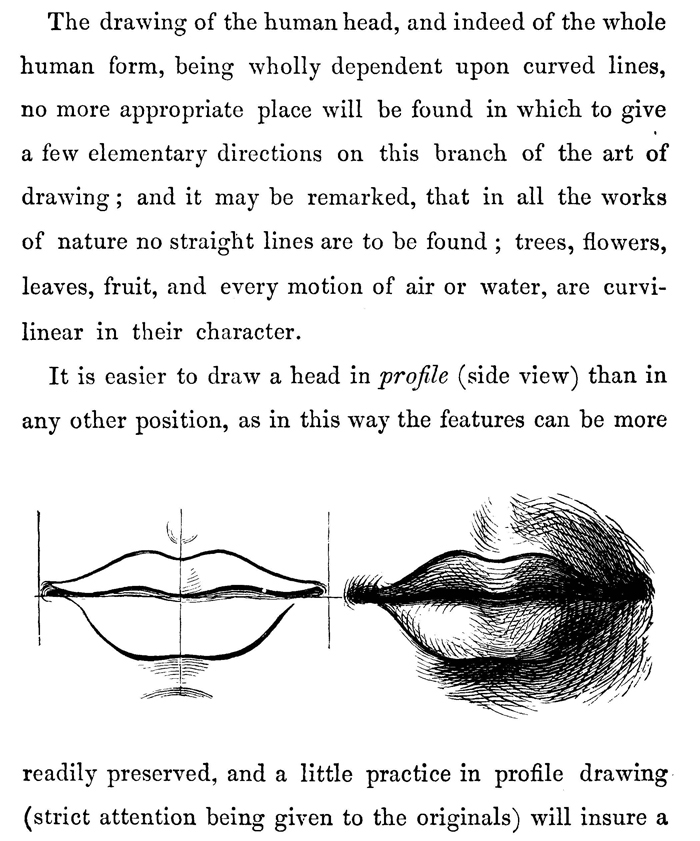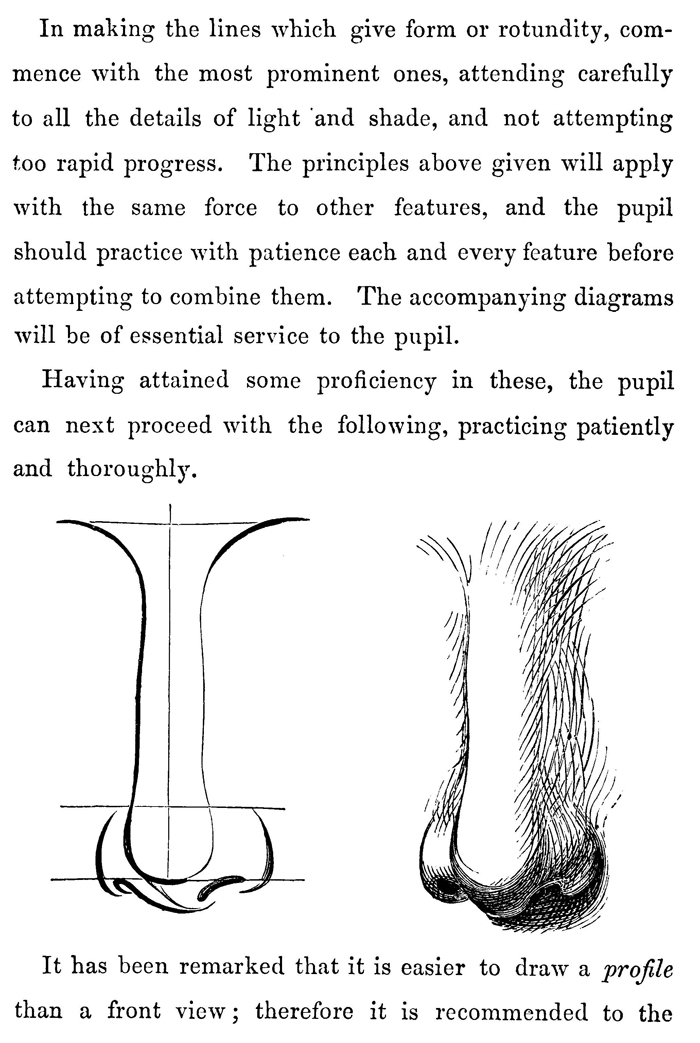Home > Directory of Drawing Lesson > Human Face > Drawing Human Heads and Faces
Drawing Human Faces & Heads : Learn how to draw facial features including mouths, lips, ears, noses, eyes, with this tutorial. |
|







Drawing the Human Head / Face
The drawing of the human head, and indeed of the whole human form, being wholly dependent upon curved lines, no more appropriate place will be found in which to give a few elementary directions on this branch of the art of drawing ; and it may be remarked, that in all the works of nature no straight lines are to be found ; trees, flowers, leaves, fruit, and every motion of air or water, are curvilinear in their character.
It is easier to draw a head in profile (side view) than in any other position, as in this way the features can be more readily preserved, and a little practice in profile drawing (strict attention being given to the originals) will insure a creditable degree of proficiency. In drawing a front view, the artist should begin with the mouth ; and as a general rule, in the words of an artist-author, " before making any attempt at expression he should become familiar with the actual form of the features, and be capable of delineating them knowingly." The line made by the meeting of the lips is the first thing to be drawn. Draw a straight line, and upon it mark with a dotted or faint line the width of the mouth, center, thickness of lips, etc., giving careful attention to the form ; then develop these marks into a correct outline of the form to be imitated, and the remaining steps of filling up will come in easy succession. Repeated experiments should be made until the use of the straight or base line can be dispensed with ; and the same principle will apply to the drawing of the eye. Practice will enable the learner in a short time to preserve the relative proportions as well without as with this line.
In making the lines which give form or rotundity, commence with the most prominent ones, attending carefully to all the details of light and shade, and not attempting too rapid progress. The principles above given will apply with the same force to other features, and the pupil should practice with patience each and every feature before attempting to combine them. The accompanying diagrams will be of essential service to the pupil.
Having attained some proficiency in these, the pupil can next proceed with the following, practicing patiently and thoroughly. It has been remarked that it is easier to draw a profile than a front view ; therefore it is recommended to the pupil to commence a perfect head with a profile ; and here nature provides a base line or point of unerring certainty, by which to produce the head. With the head in an erect position, a line connecting the lower points of the nose and car will be horizontal ; and thus is established a basis to which all the parts of the head must have certain fixed relations. Erect a perpendicular from one end of a horizontal line, and upon this mark the length of the nose, equal to one fourth the whole height of the head. This proportion will, of course, sometimes vary, but it forms a pretty accurate measurement. The oval, we mean the egg-shape oval, although of little use in profile drawing, in a full front view is of striking use and value.
The student unacquainted with the subject will be astonished to see how nearly the human face partakes of the oval form, and this knowledge, when acted upon, will be of great assistance. A single outline illustration will show better than pages of print the force of our remarks upon the oval form of the human face. The obtuse or elongated form of the oval must be determined by the individual cases.
As a general observation, it may be said that just in proportion as the head is elevated or depressed from an erect position, the line from ear to nose, before alluded to, will cease to be horizontal, and take a greater or less curvature ; still it will continue to be a governing line. Care and judgment in the use of the oval is necessary, as at every inclination of the head to the left or right, the perpendicular or center ceases to be a straight line, and as the curvature increases the line loses its position as a central line for determining the features, while the oval is gradually lost for an outline as the picture q preaches a profile. The imaginary central line of the head and face should always receive the careful study and continual attention of the student, as it determines the general character of the head and its separate parts.
Copying plaster casts is an excellent practice, and the learner should improve every opportunity for observation and study ; and all attempts at imitation, either from casts, living heads, or paintings, will insure gratifying progress in the art. Proper subjects for copying are within the reach of all those into whose hands this book will fall. As the pupil passes on to advance pages, he will find various directions for the minutiae of drawing, which will be of use in all his attempts to represent the human head.




